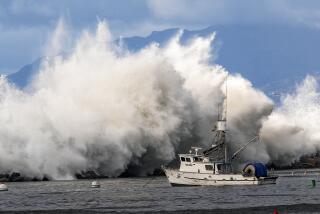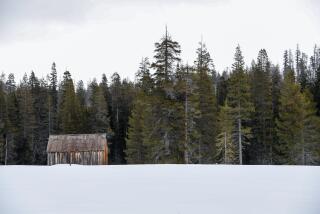Southland Prepares for Worst Winter in Decades
Prodded by ominous warnings that the most turbulent El Nino winter weather in decades may be lurching toward California, residents and government agencies are scrambling for ways to survive the expected onslaught of wind, water and waves.
Drains and flood channels are being cleaned, levees bolstered, trees chopped, brush cleared, evacuation plans and Red Cross shelter lists renewed, and damage control crews put through special training to help avoid the kind of damage and paralysis inflicted when relentless El Nino storms pounded the West Coast in 1982-83.
In San Diego, lifeguards are receiving special “swift river rescue” training so they can serve as a kind of aquatic SWAT squad. Marine mammal rescue squads in San Pedro and Laguna Beach are bracing for the specter of hundreds of helpless animals being tossed onto beaches by the storms.
Work and training continues apace throughout the region even though the sky is balmy, the surf gentle and thoughts of a tough winter hard to conjure. If experts are correct, the storms could hit as early as September and last through March or even longer.
Roofing contractors and gutter specialists report an increase in business.
Dave Danielson, a science and operations officer for the National Weather Service who lives near the flood-prone Santa Clara River in Ventura County, plans to increase his flood insurance.
“A little mitigation will go a long way,” said Nicholas E. Graham, an El Nino expert at the Scripps Institution of Oceanography in La Jolla.
Two hundred and fifty disaster preparedness and flood control officials attended a daylong meeting Tuesday at Scripps to hear the ominous predictions about El Nino and swap survival suggestions.
Some mega-agencies, such as the Los Angeles County Department of Public Works and the city’s Department of Water and Power, express confidence that they are ready come what may, but smaller agencies with smaller budgets are not as sure.
John Clement, public works director in Malibu, one of the hardest-hit areas during the 1982-83 storms, plans to train the entire city staff in emergency measures and has also scheduled a disaster drill for volunteers, homeowners and public employees.
Nevertheless, with a public works staff of only five people, Clement is worried that Malibu will not have the resources to handle a storm series that could be worse than the El Nino-induced winter weather of 1982-83.
“Our storm drains are 50 years old, they’re collapsing, they’re at the end of their life span,” Clement said.
Still, storm predictions are not all doom and gloom. Roofers and other contractors are enjoying a bonanza.
“All of a sudden it got busy since the news reports came out,” said Geovany Mora, owner of Geovany’s Roofing in Canoga Park. He said phone calls asking for estimates were 75% higher than normal.
“There is enough word going around about El Nino and the need to weatherproof your home, that I’d say in the last month and a half our calls have increased at least by 100%,” said Alan Smith, operations manager for A-1 Rain Gutters in Glendale.
But for most businesses, the expected storms just mean more work.
Southern California Edison is training 500 employees to use a 2-year-old, multimillion-dollar outage management system. In 1982-83, El Nino damage cost the company $15 million and left thousands of customers without power for days.
“By the time El Nino hits us, we will be able to determine problems before customers call us,” a company spokesman said.
San Diego Gas & Electric Co. is re-upping its mutual aid pacts with utility companies throughout the state and refining its damage assessment and power restoration plans, a spokesman said.
Chris Bach, emergency management coordinator for the city of San Diego, has been ordered to prepare a detailed battle plan for the City Council complete with evacuation plans, Red Cross shelters and engineering projects to widen earthen flood channels in the easily flooded Tijuana River Valley near the Mexican border.
Emergency officials in San Diego are working with their counterparts in Tijuana to help that metropolis. Mudslides in 1993 killed dozens of people in Tijuana’s poorer neighborhoods.
City of Los Angeles’ tree trimmers are busy pruning and removing dying Carolina cherry and Siberian elm trees to cut down the number of accidents caused by trees felled by storms.
“We’re expecting the El Nino,” said Darrell Espy, a tree surgeon supervisor for the city. “We’re trying to get ahead of the storm with preventive maintenance.”
In the San Gabriel foothill neighborhood of Pasadena Glen, residents are banking on their emergency telephone tree and on the big culverts built after a disastrous 1994 deluge left residents knee-deep in mud.
“If you have biblical rains--six to 10 inches a day over several days--everybody better watch out, not just us,” said Linda Williams, president of the Pasadena Glen homeowners’ group. “That’s when mountains can move.”
But government, in Orange County and elsewhere, can only do so much. The rest is up to an aroused and prepared citizenry.
Orange County Fire Capt. Scott Brown is warning residents to clear gutters, patch leaky roofs and plant shrubbery in bare slopes to prevent mudslides. “Now is the time to fix it,” Brown said. “Don’t wait till the rains come.”
One prediction is that rain in September, October and November will be 200% of normal, and in January, February and March, it will be 300%.
“This is an event to be reckoned with,” Graham said. “There is the possibility of extreme events. Three hundred percent of normal is as large as it gets in Southern California.”
Similar predictions have come from the director of the Climate Prediction Center at the National Oceanic and Atmospheric Assn. in Washington. “I think this particular [El Nino] is going to be as big as the strong one of 1982-83,” said director Ants Leetmaa.
Another prediction is that the storms could bring the kind of immense, pounding waves not seen since 1982-83, which saw the biggest waves ever recorded in the Northern Hemisphere. Described as the “event of the century” in terms of West Coast weather, those storms did $265 million in damage in California, were responsible for 14 deaths and forced evacuation of 15,000 people.
“The signs are there,” said Scripps researcher Richard Seymour.
Although several agencies with expertise in gauging weather patterns have predicted a wet winter due to El Nino, experts concede that El Nino is a phenomenon that is not entirely understood and that predictions are tricky.
El Nino--Spanish for “the child” because the phenomenon occurs near Christmas--is the name given to the interplay between warm currents in the Pacific Ocean off South America and changes in atmospheric temperature, wave patterns and rain levels along the West Coast.
Already, water temperatures have risen 4 1/2 to 5 degrees (Celsius) higher than normal, and ahead of the warming noticed in 1982. Ecuador, Chile and other South American countries are experiencing severe storms with high rainfall and flooding.
Many areas in Southern California are still repairing damage left by El Nino in 1983 and other winter storms in recent years. Redondo Beach has been replacing storm drains and inlets in residential areas throughout the city in areas hard hit by the rains generated by El Nino in 1983 and by major storms three years ago.
“We can handle steady rain all winter long. That’s not the problem,” said Redondo Beach City Manager Paul Connolly. “It’s the big 100-year storm we’re worried about.”
Contributing to this story were Times staff writers Ken Ellingwood in the San Gabriel Valley, Robert Lee Hotz in La Jolla, Tony Perry in San Diego and Lorenza Munoz and David Reyes in Orange County and correspondents Deborah Belgum in Redondo Beach, Tracy Johnson in San Pedro and Nick Green in Ventura.
More to Read
Sign up for Essential California
The most important California stories and recommendations in your inbox every morning.
You may occasionally receive promotional content from the Los Angeles Times.









